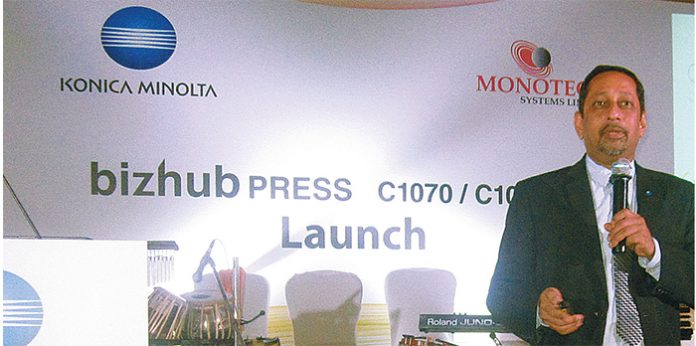
On 9 June 2014 Konica Minolta and its Indian partner Monotech Systems showed
the newly launched C1070 and C1060 at Hotel Courtyard Marriot in Mumbai. The new series is a flexible color digital printing system that complements offset business.
Designed to meet demanding job requirements in short turnaround time, the series is versatile enough to handle a wide range of print applications with improved media handling. According to the company, with Konica Minolta’s new proprietary
Simitri High DefinitionE (HDE) toner and Screen-Enhancing Active Digital IV (SEAD IV) image processing system, near offset print quality can be
achieved.
Streamlining workflow
The new series maintains high-level productivity with 60 and 71 A4 pages per minute respectively. This includes advanced paper handling technologies for smooth print runs with the enhanced air-assisted paper feeder options (PF-602, LU-202) to eliminate paper jams. Konica Minolta exclusive IC-602 helps to streamline workflow management, and provide powerful print queue control and intuitive on-screen job editing capabilities to simplify work and speed output. The easy integration into existing offset workflows and the comprehensive range of in-line finishing options enable customers to meet complex demand and fast turnaround times.
“The new series improves upon the successful bizhub C6500 and C7000 series. The line was due for a change as customers wanted improvement in not only speed but also wanted to create greater value in terms of media and the way colors are handled. In other words the idea was to provide solutions on how to add value yet keep it affordable,” V Balakrishnan, executive general manager, marketing division of Konica Minolta told Indian Printer and Publisher on the sidelines of the event.
Printing hubs
According to Balakrishnan, these new
Konica Minolta shows its new bizhub C1070 and C1060 in Mumbai
Flexible color digital printing system
V Balakrishnan, executive general manager, marketing division of Konica Minolta emphasized the importance of localization of content which should generate more distributed print. Photo IPP
presses would be very handy for commercial offset printers who want to attend to the digital segment to some extent. At the function, Balakrishnan talked about the first Digital imaging square (DIS) in India at its corporate office in Gurgaon, Haryana. The DIS, which is fully equipped with solutions from prepress to final product, was inaugurated in June last year with an investment of US$ 1.5 million.
“DIS provides a platform where people can put forth their ideas. This is our way of showing commitment to the market and customers. There have been many people who have spent considerable time there but we want to attract more people,” Balakrishnan said. For the company the Indian market has been a success story. “The Indian market has been an eye opener for us. We have managed to replicate some of our Indian experiences in other countries as well,” Balakrishnan added.
Commenting on the Indian
market and the role of the digital printing segment, Balakrishnan said no other country has so many languages which means there is a huge opportunity for localization of content. “With localization you need more distributed print. Going forward I see digital growing with more printing hubs coming up in India as only few printing entities cannot claim to provide for so many languages and such varied geographies,” he said.
“The best prescription for success in the current competitive world is to listen to the customers. Margin pressure is a phenomenon that is seen across industries. Printers have to think whether they want to just be volume players and work on laser thin margins or they want to understand customers and do something unique for them.
There are people in the market who create value for customers and that is how you can remain relevant for your customers and for the market,”
Balakrishnan concluded.











